Bronze Age - Egypt and North Africa - Recent acquisitions - Sold antiquities
Archive of sold antiquities
All artefacts sold in our gallery are fully documented in our online archive and database. Being a specialist ancient art dealer, preserving also the more recent history of each and every piece sold in our shop is at our heart. That is particularly useful for artefacts that changed owners in the meantime. Information that may have been lost in the process can be easily restored from our archives. Please do not hesitate to contact us if you need further information about ancient items that have been sold in our gallery. We can help you with reconstructing the history of ownership for those items. All information about our customers will be kept confidential, of course.-
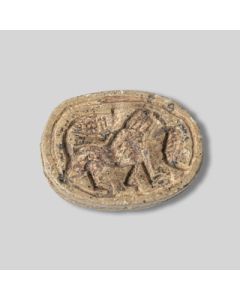 Egyptian scarab with lion
Egyptian scarab with lionAmulet seal from ancient Egypt. From the Gaze Cooper collection.
Price: on request Egyptian model vessels of a founding ceremony
Egyptian model vessels of a founding ceremonyA group of seven miniature bowls and three miniature vases made of clay. Once filled with offerings and used ritually during a foundation stone laying ceremony. Dating to the Old Kingdom, around 2500 BC.
Price: on request Egyptian stone beaker
Egyptian stone beakerThe elegant stone vase was probably used as an ointment vessel. 5th to 6th dynasty of ancient Egypt, Old Kingdom.
Price: on request Egyptian faience figurine of Sekhmet
Egyptian faience figurine of SekhmetProtective amulet in the form of a statuette of the lion-headed goddess with a hieroglyphic inscription on the back. A wonderful and large faience from the Third Intermediate Period of Ancient Egypt.
Price: on request Egyptian chalice
Egyptian chaliceThe thin-walled stone cup is reminiscent of a lotus bud. From the collection of Egyptologist Professor Wiedemann. 18th dynasty of Ancient Egypt.
Price: on request Slender Egyptian stone beaker
Slender Egyptian stone beakerThe small and tall stone vessel is made of alabaster. From the collection of Egyptologist Professor Wiedemann.
Price: on request Flint blade and stone mould
Flint blade and stone mouldInteresting group of two artefacts. A Neolithic flint blade from Egypt and a Bronze Age mould for casting or hammering metal.
Price: on request Clay ushabti
Clay ushabtiTall Egyptian funerary statuette from the New Kingdom. From the collection of the archaeologist and artist Erich Charlier.
Price: on request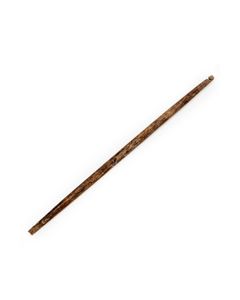 Egyptian spindle shaft made of wood
Egyptian spindle shaft made of woodExceptionally rare main piece of a hand spindle. A find from Thebes in Upper Egypt. From the reign of pharao Senusret II, around 1840 BC.
Price: on request Egyptian hippopotamus amulet
Egyptian hippopotamus amuletMade in the style of a scarab but with a hippopotamus on the upper side. It was a protective amulet during the 18th or 19th dynasty of Ancient Egypt. It might have protected a pregnant woman. The amulet comes from the famous Matouk collection and is published in his 1971 book.
Price: on request Egyptian scarab
Egyptian scarabAmulet seal with pseudo hieroglyphs on the underside. Late or post Ramesside period.
Price: on request Egyptian scarab with spiral design
Egyptian scarab with spiral designAmulet seal in the shape of a scarab with schematic top side. Second Intermediate Period of ancient Egypt.
Price: on request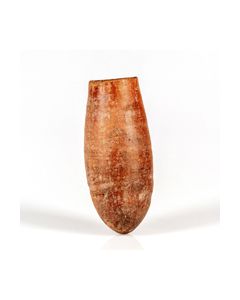 Egyptian predynastic redware jar
Egyptian predynastic redware jarSimple pottery vessel of timeless elegance. From the Naqada I period, 4th Millenium BC.
Price: on request Egyptian scarab
Egyptian scarabAmulet seal in the shape of a scarab with schematic top side and braided tape on the underside. Second Intermediate Period of ancient Egypt.
Price: on request Egyptian Kohl vessel
Egyptian Kohl vesselThe small stone pot of nicely polished granite was used for Kohl, the eye cosmetic of the ancient Egyptians. From the time between Middle Kingdom and New Kingdom.
Price: on request Egyptian scarab with knot design
Egyptian scarab with knot designAmulet seal with a complex knot design on the underside, possibly symbolizing the unity of Egypt. Second Intermediate Period of ancient Egypt.
Price: on request Egyptian scarab with interesting stamp design
Egyptian scarab with interesting stamp designAmulet seal with a complex knot design on the underside, possibly symbolizing the unity of Egypt. Second Intermediate Period of ancient Egypt.
Price: on request Egyptian button seal
Egyptian button sealAmulet seal as a good luck charm with a protective function. Second Intermediate Period of ancient Egypt.
Price: on request Scarab with cross design
Scarab with cross designAmulet seal with complex design of crosses on the underside. Second Intermediate Period of ancient Egypt.
Price: on request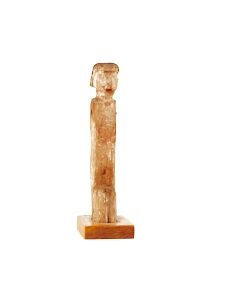 Egyptian wooden statuette
Egyptian wooden statuetteFigure painted in black and red from the 12th dynasty of ancient Egypt. Probably part of a larger wooden model for a tomb.
Price: on request Egyptian wooden statuette
Egyptian wooden statuetteFigure painted in black and red from the 12th dynasty of ancient Egypt. Probably part of a larger wooden model for a tomb.
Price: on request Egyptian scarab with cross design
Egyptian scarab with cross designAmulet seal with complex design of crosses on the underside. Second Intermediate Period of ancient Egypt.
Price: on request Egyptian wooden ushabti
Egyptian wooden ushabtiWonderful figurine from the 18th dynasty of ancient Egypt. It has an interesting provenance and exhibition record.
Price: on request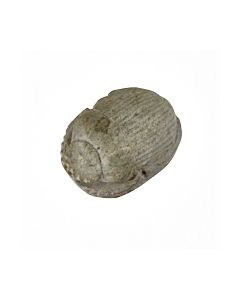 Egyptian scarab
Egyptian scarabThe scarab is made of beautiful green stone. Schematical upper side, unengraved bottom side. From the New Kingdom of Ancient Egypt.
Price: on request Scarab with magic formula
Scarab with magic formulaThe stamp shows the anra formula in a cartouche. The amulet should thus serve a magic or ritual purpose for its owner.
Price: on request Egyptian Eye of Horus, New Kingdom
Egyptian Eye of Horus, New KingdomSmall amulet in form of the Eye of Horus. Popular type of protective amulet from Ancient Egypt.
Price: on request Egyptian Eye of Horus
Egyptian Eye of HorusSmall amulet in form of the Eye of Horus. Popular type of protective amulet from Ancient Egypt.
Price: on request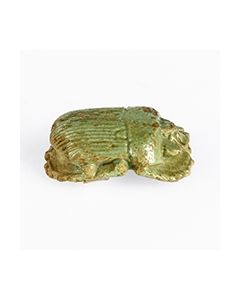 Naturalistic scarab
Naturalistic scarabFunerary scarab in mint green fayence. New Kingdom of Ancient Egypt. The piece is from the famous Matouk collection.
Price: on request Egyptian funerary figurine for Nefer-hotep
Egyptian funerary figurine for Nefer-hotepInteresting ushabti from Memphis dating to the late 19th Dynasty, New Kingdom. The owner was an official from the Temple of Ptah.
Price: on request Faience tile of the Djoser pyramid type
Faience tile of the Djoser pyramid typeEgyptian wall tile from the Old Kingdom, 2nd to 3rd dynasty. The tile type is known from the famous step pyramid of king Djoser.
Price: on request Pre-Dynastic pottery of Ancient Egypt
Pre-Dynastic pottery of Ancient EgyptThe simple vessel is made of coarse clay. It dates to the end of the 4th millenium BC and hence witnessed the beginning of the Ancient Egyptian civilization.
Price: on request Cowroid with decorated body
Cowroid with decorated bodyThe cowroid has an interesting decoration across the upper surface. The lower surface is inscribed with hieroglyphs. This cowroid is discussed in the catalogue of Gautier-Vodoz.
Price: on request Scaraboid from the Middle Kingdom
Scaraboid from the Middle KingdomThe stamp shows hieroglyphs with a title for the king of Upper and Lower Egypt. This scaraboid is described in the catalogue of Irène Gautier-Vodoz.
Price: on request Scarab with lion
Scarab with lionThe scene shows a walking lion. It is framed by an oval cord. This scarab is described in the catalogue of Irène Gautier-Vodoz.
Price: on request Scarab with geometric motive
Scarab with geometric motiveThe motive exhibits two symmetry axes and at least six triangles. A wonderful artistic expression of the highly evolved Egyptian maths. This scarab is described in the catalogue of Irène Gautier-Vodoz.
Price: on request Scarab with pattern of circles
Scarab with pattern of circlesThe beetle stone bears a popular motive of the Middle Empire. A nice example of its kind. This scarab is described in the catalogue of Irène Gautier-Vodoz.
Price: on request

